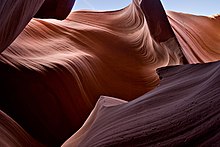The sedimentary rock cover of the continents of the Earth's crust is extensive, but the total contribution of sedimentary rocks is estimated to be only 8% of the total volume of the crust.[1] Sedimentary rocks are only a thin veneer over a crust consisting mainly of igneous and metamorphic rocks. Sedimentary rocks are deposited in layers as strata, forming a structure called bedding. The study of sedimentary rocks and rock strata provides information about the subsurface that is useful for civil engineering, for example in the construction of roads, houses, tunnels, canals or other constructions. Sedimentary rocks are also important sources of natural resources like coal, fossil fuels, drinking water or ores.
The study of the sequence of sedimentary rock strata is the main source for scientific knowledge about the Earth's history, including palaeogeography, paleoclimatology and the history of life. The scientific discipline that studies the properties and origin of sedimentary rocks is called sedimentology. Sedimentology is both part of geology and physical geography and overlaps partly with other disciplines in the Earth sciences, such as pedology, geomorphology, geochemistry or structural geology.
Contents |
Genetic classification
Based on the processes responsible for their formation, sedimentary rocks can be subdivided into four groups: clastic sedimentary rocks, biochemical (or biogenic) sedimentary rocks, chemical sedimentary rocks and a fourth category for "other" sedimentary rocks formed by impacts, volcanism, and other minor processes.Clastic sedimentary rocks
Main article: Clastic rock

Claystone deposited in Glacial Lake Missoula, Montana, United States. Note the very fine and flat bedding, common for distal lacustrine deposition.
Clastic sediment, and thus clastic sedimentary rocks, are subdivided according to the dominant particle size (diameter). Most geologists use the Udden-Wentworth grain size scale and divide unconsolidated sediment into three fractions: gravel (>2 mm diameter), sand (1/16 to 2 mm diameter), and mud (clay is <1/256 mm and silt is between 1/16 and 1/256 mm). The classification of clastic sedimentary rocks parallels this scheme; conglomerates and breccias are made mostly of gravel, sandstones are made mostly of sand, and mudrocks are made mostly of mud. This tripartite subdivision is mirrored by the broad categories of rudites, arenites, and lutites, respectively, in older literature.
Subdivision of these three broad categories is based on differences in clast shape (conglomerates and breccias), composition (sandstones), grain size and/or texture (mudrocks).
Conglomerates and breccias
Conglomerates are dominantly composed of rounded gravel and breccias are composed of dominantly angular gravel.Sandstones
Sandstone classification schemes vary widely, but most geologists have adopted the Dott scheme,[2] which uses the relative abundance of quartz, feldspar, and lithic framework grains and the abundance of muddy matrix between these larger grains.- Composition of framework grains
- The relative abundance of sand-sized framework grains determines the first word in a sandstone name. For naming purposes, the abundance of framework grains is normalized to quartz, feldspar, and lithic fragments formed from other rocks. These are the three most abundant components of sandstones; all other minerals are considered accessories and not used in the naming of the rock, regardless of abundance.
-
-
- Quartz sandstones have >90% quartz grains
- Feldspathic sandstones have <90% quartz grains and more feldspar grains than lithic grains
- Lithic sandstones have <90% quartz grains and more lithic grains than feldspar grains
-
- Abundance of muddy matrix between sand grains
- When sand-sized particles are deposited, the space between the sand
grains either remains open or is filled with mud (silt and/or clay sized
particle).
- "Clean" sandstones with open pore space (that may later be filled with cement) are called arenites
- Muddy sandstones with abundant (>10%) muddy matrix are called wackes.
- When sand-sized particles are deposited, the space between the sand
grains either remains open or is filled with mud (silt and/or clay sized
particle).
Although the Dott classification scheme[2] is widely used by sedimentologists, common names like greywacke, arkose, and quartz sandstone are still widely used by nonspecialists and in popular literature.
Mudrocks

Lower Antelope Canyon was carved out of the surrounding sandstone by both mechanical weathering and chemical weathering. Wind, sand, and water from flash flooding are the primary weathering agents.
Most authors presently use the term "mudrock" to refer to all rocks composed dominantly of mud.[3][4][5][6] Mudrocks can be divided into siltstones (composed dominantly of silt-sized particles), mudstones (subequal mixture of silt- and clay-sized particles), and claystones (composed mostly of clay-sized particles).[3][4] Most authors use "shale" as a term for a fissile mudrock (regardless of grain size), although some older literature uses the term "shale" as a synonym for mudrock.
Biochemical sedimentary rocks
Biochemical sedimentary rocks are created when organisms use materials dissolved in air or water to build their tissue. Examples include:- Most types of limestone are formed from the calcareous skeletons of organisms such as corals, mollusks, and foraminifera.
- Coal which forms as plants remove carbon from the atmosphere and combine with other elements to build their tissue.
- Deposits of chert formed from the accumulation of siliceous skeletons from microscopic organisms such as radiolaria and diatoms.

No comments:
Post a Comment